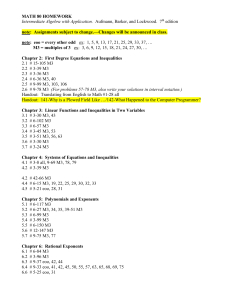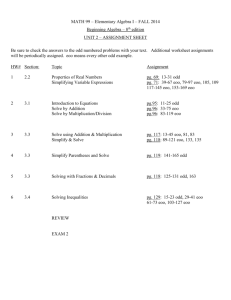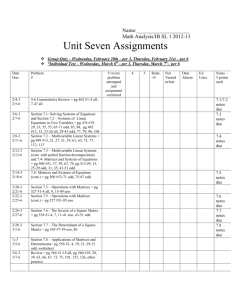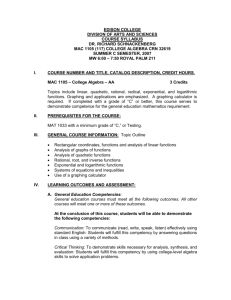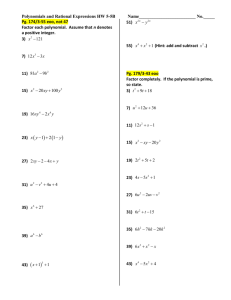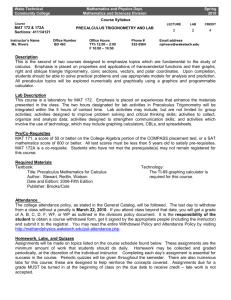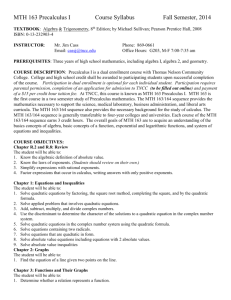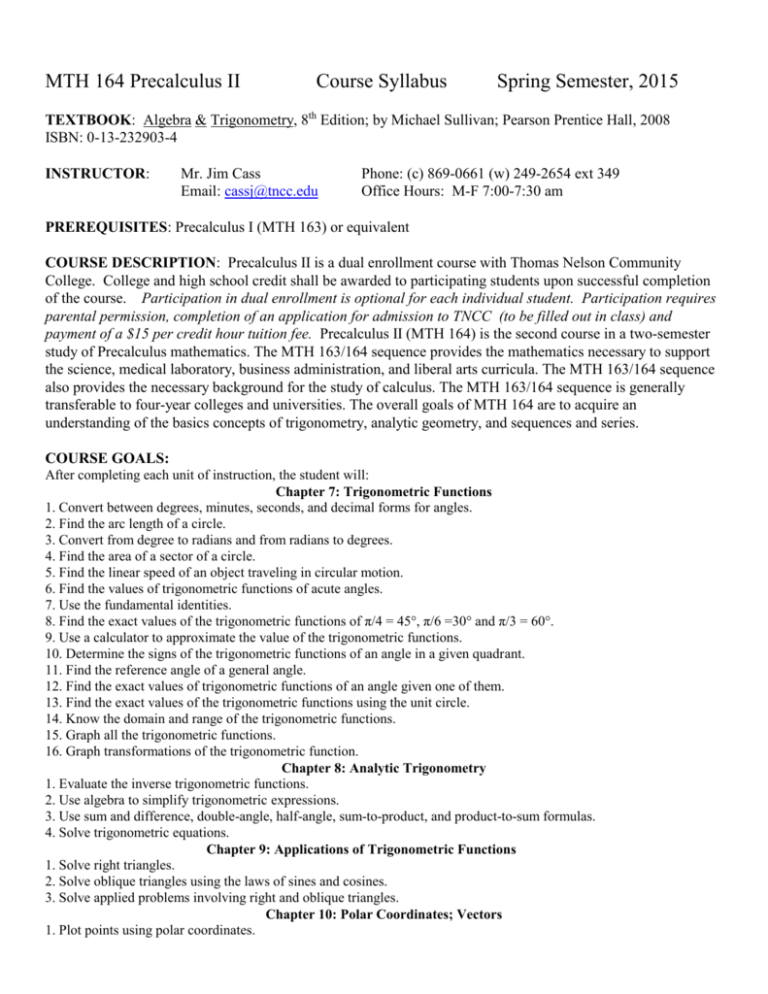
MTH 164 Precalculus II
Course Syllabus
Spring Semester, 2015
TEXTBOOK: Algebra & Trigonometry, 8th Edition; by Michael Sullivan; Pearson Prentice Hall, 2008
ISBN: 0-13-232903-4
INSTRUCTOR:
Mr. Jim Cass
Email: cassj@tncc.edu
Phone: (c) 869-0661 (w) 249-2654 ext 349
Office Hours: M-F 7:00-7:30 am
PREREQUISITES: Precalculus I (MTH 163) or equivalent
COURSE DESCRIPTION: Precalculus II is a dual enrollment course with Thomas Nelson Community
College. College and high school credit shall be awarded to participating students upon successful completion
of the course. Participation in dual enrollment is optional for each individual student. Participation requires
parental permission, completion of an application for admission to TNCC (to be filled out in class) and
payment of a $15 per credit hour tuition fee. Precalculus II (MTH 164) is the second course in a two-semester
study of Precalculus mathematics. The MTH 163/164 sequence provides the mathematics necessary to support
the science, medical laboratory, business administration, and liberal arts curricula. The MTH 163/164 sequence
also provides the necessary background for the study of calculus. The MTH 163/164 sequence is generally
transferable to four-year colleges and universities. The overall goals of MTH 164 are to acquire an
understanding of the basics concepts of trigonometry, analytic geometry, and sequences and series.
COURSE GOALS:
After completing each unit of instruction, the student will:
Chapter 7: Trigonometric Functions
1. Convert between degrees, minutes, seconds, and decimal forms for angles.
2. Find the arc length of a circle.
3. Convert from degree to radians and from radians to degrees.
4. Find the area of a sector of a circle.
5. Find the linear speed of an object traveling in circular motion.
6. Find the values of trigonometric functions of acute angles.
7. Use the fundamental identities.
8. Find the exact values of the trigonometric functions of π/4 = 45°, π/6 =30° and π/3 = 60°.
9. Use a calculator to approximate the value of the trigonometric functions.
10. Determine the signs of the trigonometric functions of an angle in a given quadrant.
11. Find the reference angle of a general angle.
12. Find the exact values of trigonometric functions of an angle given one of them.
13. Find the exact values of the trigonometric functions using the unit circle.
14. Know the domain and range of the trigonometric functions.
15. Graph all the trigonometric functions.
16. Graph transformations of the trigonometric function.
Chapter 8: Analytic Trigonometry
1. Evaluate the inverse trigonometric functions.
2. Use algebra to simplify trigonometric expressions.
3. Use sum and difference, double-angle, half-angle, sum-to-product, and product-to-sum formulas.
4. Solve trigonometric equations.
Chapter 9: Applications of Trigonometric Functions
1. Solve right triangles.
2. Solve oblique triangles using the laws of sines and cosines.
3. Solve applied problems involving right and oblique triangles.
Chapter 10: Polar Coordinates; Vectors
1. Plot points using polar coordinates.
2. Convert from polar coordinates to rectangular coordinates and visa versa.
3. Convert a complex number from rectangular form to polar form and visa versa.
4. Plot points in the complex plane.
5. Find products and quotients of complex numbers in polar form.
6. Use De Moivre’s theorem.
7. Find complex roots.
8. Graph vectors.
9. Find the position vector for an arbitrary vector.
10. Add and subtract vectors.
11. Find the magnitude of a vector.
11. Find a scalar product of two vectors.
12. Find the corresponding unit vector for an arbitrary vector.
13. Find a vector given its direction and magnitude.
Chapter 11: Analytic Geometry
1. Find the equation of a parabola, ellipse, and hyperbola.
2. Graph parabolas, ellipses, and hyperbolas.
3. Solve applied problems involving the conic sections.
Chapter 13: Sequences; Induction; the Binomial Theorem
1. Write the first several terms of a sequence.
2. Write the terms of a sequence defined by a recursive formula.
3. Use summation notation.
4. Determine if a sequence is arithmetic, geometric, or neither
5. Find a formula for the nth term of an arithmetic and geometric sequence.
6. Find the sum of an arithmetic and geometric sequence.
COURSE MEETING TIMES: Monday through Friday, 1st period.
HOMEWORK: Homework problems for each section will be assigned on a regular basis. The assigned
problems are included at the end of this syllabus. Each student is expected to study the assigned material and to
work the assigned problems before coming to class. Some class time will be spent discussing the difficulties
encountered with the homework exercises. Although homework is not collected and graded, you cannot be
successful in this course without doing the homework.
INSTRUCTIONAL METHODS: The course content will be taught primarily through a series of lectures with
ample class time being reserved for student questions and interaction. Classroom participation is a definite part
of the instructional process. Students are encouraged to ask questions in class and demonstrate their ability to
solve problems.
TESTING: Eight tests are scheduled as well as a mandatory, comprehensive final exam. Quizzes will be given
periodically as well. Quizzes will normally cover two sections. All tests and quizzes will be announced with
ample opportunity for preparation.
ALTERNATE SOURCES OF INSTRUCTION (available at TNCC to dual enrollment students):
Instructional Videos: Khan Academy, www.khanacademy.org
The College Math Center: Library in Wythe Hall. The math center is available for students who need additional
help outside of class.
Tutorial Learning Center: Wythe Hall Room 253. The tutorial center is available to assist currently enrolled
students desiring additional help in their classes by providing them with peer tutors (when available).
GRADING POLICY: Grades are determined on a point system. Tests are worth 100 points, quizzes are
normally 20 points, pop quizzes are 5 or 10 points. Extra credit is available by attendance at Jefferson Lab
Science Series Lectures or the Air & Space Museum Sigma Series lectures. Each lecture is worth 10 points and
students are limited to 10 points per quarter per class.
HOMEWORK ASSIGNMENTS
Section
7.1
7.3
7.5
7.7
8.1
8.3
8.5
8.8
9.2
9.4
10.3
11.1
11.3
13.1
13.3
Homework
13 – 89 EOO*
5 – 45 odd
9 – 77 EOO
17 – 41 EOO
9 – 49 odd
9 – 65 EOO
9 – 27, 69 – 75 odd
5 – 45 EOO
9 – 49 EOO
5 – 33 EOO
13 – 57 EOO
Read p. 772
17 – 73 EOO
9 – 77 EOO
9 – 81 EOO
Section
7.2
7.4
7.6
7.8
8.2
8.4
8.7
9.1
9.3
10.1
10.4
11.2
11.4
13.2
13.5
Homework
13 – 61 odd
13 – 105 EOO
9 – 27 odd, 45 – 69 EOO
1 – 23 odd, 31
9 – 65 EOO
9 – 35 odd
9 – 45 odd
9 – 29 odd
9 – 41 EOO
13 – 73 EOO
9 – 49 EOO
21 – 73 EOO
17 – 57 EOO
5 – 49 EOO
5 – 41 EOO
*EOO means every other odd
ATTENDANCE REQUIREMENTS:
Regular school attendance is essential for a student’s academic success. When an absence
occurs, a parent / guardian should contact the school office that day to report and provide a
reason for the absence. Following an absence, it is important for a student to complete make-up
work to compensate for missed class time and to maintain a satisfactory grade. Missing class
due to participation in a school-sponsored activity does not count as an absence, but assignments
must be completed on time.
A student must be in school 4 hours (Middle School / High School: attend 4 classes) to be
marked present for the day. Student athletes marked absent for the day are not eligible to
participate in practice or games that day, unless approved by the Principal or Administrator.
Students must complete assignments in classes missed due to late arrival or early dismissal, or
grades will be reduced.
Any student who attains 10 absences in a semester will be placed under review by the Principal.
Absences in excess of 10 per semester may result in failing grades, loss of course credit, and may
jeopardize promotion to the next grade. The school administration will make the final decision
whether a student will pass or fail after contacting parent / guardians and reviewing the
circumstances of the absences.
Seniors with more than 5 absences in a class, excused or unexcused, will not be exempt from the
semester exam in that class. Approved college visits, and missing class due to participation in a
school-sponsored activity will not affect exam exemption.
LATE WORK/MAKE-UP/MISSED TEST POLICY: If a student misses a test or quiz due to an excused
absence, then the student is expected to make up the quiz or test as soon as possible upon return to school.
Makeup quizzes and tests will normally be done outside of class time, preferably in the morning before school
starts.
LAST DAY TO WITHDRAW WITH A “W” GRADE: April 20, 2014
INSTRUCTIONAL METHODS: The course content will be taught primarily through a series of lectures with
ample class time being reserved for student questions and interaction. Classroom participation is a vital part of
the instructional process. Students are encouraged to ask questions in class and demonstrate their ability to
solve problems.
ALTERNATE SOURCES OF INSTRUCTION (available at TNCC to dual enrollment students):
Instructional Videos: Khan Academy, www.khanacademy.org
The College Math Center: Library in Wythe Hall. The math center is available for students who need additional
help outside of class.
Tutorial Learning Center: Wythe Hall Room 253. The tutorial center is available to assist currently enrolled
students desiring additional help in their classes by providing them with peer tutors (when available).
STUDENTS WITH DISABILITIES.
DBCS believes every child deserves a quality education, regardless of physical, mental, or
emotional disabilities. However, facility, Faculty, and financial constraints make it impossible
for DBCS to accommodate children with disabilities at this time. Since we are unable to create a
proper learning environment, it would be a disservice to allow admission to children with
disabilities. Furthermore, if a current DBCS student is tested and diagnosed with a specific kind
of disability the school cannot accommodate, then the student will be released from the school.
The final decision on any admission shall be exclusively reserved to the School Management
Team. The Team’s decision is not subject to review or appeal.
CALCULATORS: A graphing calculator is an essential tool for this course and each student is expected to
have one. The TI-84 PLUS calculator is recommended because that is the model that will be used for
demonstrations in class.
STATEMENT ON PLAGIARISM/ACADEMIC HONESTY:
Scholastic dishonesty of any form will not be tolerated. Actions for scholastic dishonesty may include grade
reduction, failing grade for course, and/or recommendation for possible dismissal from the college.
POLICY ON CONTAGIOUS DISEASES.
Parents / guardians are asked to keep all students with fevers and contagious illnesses home.
This is a health consideration for the well-being of all our students, Faculty, and Staff. After the
illness, students need a signed note from parent / guardian stating the reason for missing school.
School policy is that a student must stay home with the following conditions:
Flu symptoms
Diarrhea (24 hours fever free without medication before returning to school)
Colored nasal discharge
Persistent cough
Fever (24 hours fever free without medication before returning to school)
Vomiting due to illness (24 hours without vomiting before returning to school)
Strep Throat (24 hours on medication before returning to school)
Pinkeye (24 hours on medication before returning to school)
Students do, at times, come down with illnesses while at school. If that happens, the student will
be sent to the school clinic for evaluation by the school’s EMT to determine if the student should
stay in school or be sent home. If a student needs to be sent home, every effort will be made to
contact a parent / guardian. If a parent / guardian is not available, an emergency contact person
will be notified. Sick students will remain in the clinic until someone comes to pick them up.

